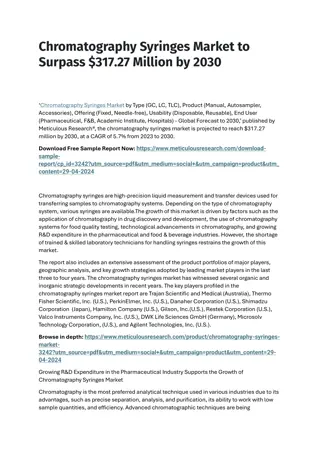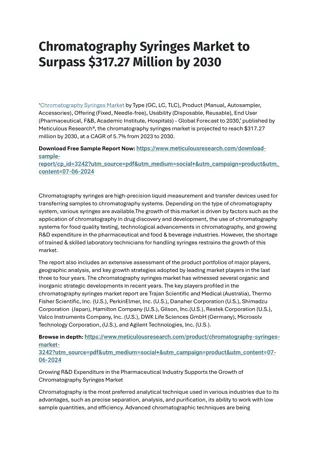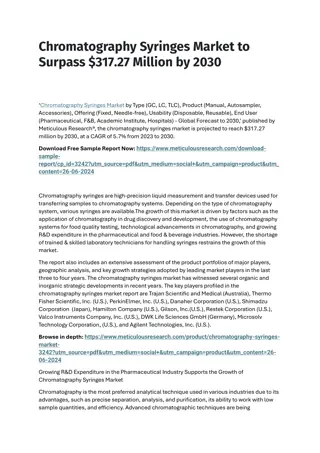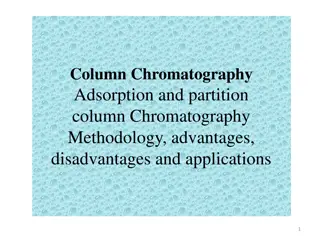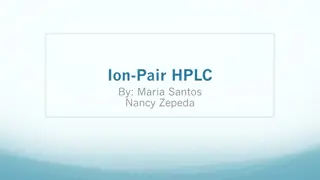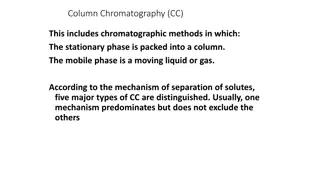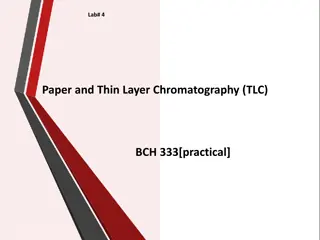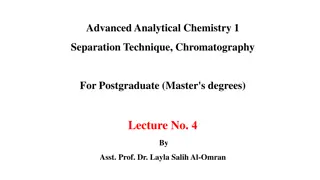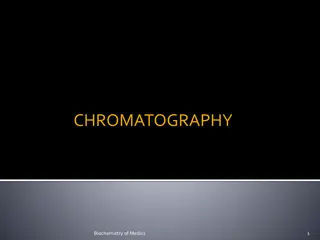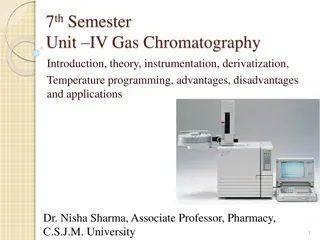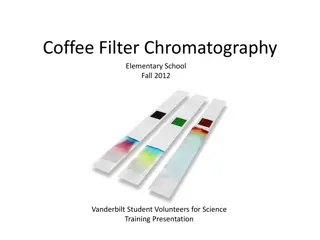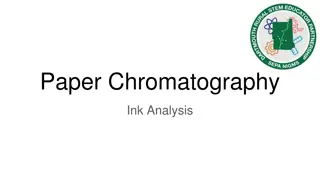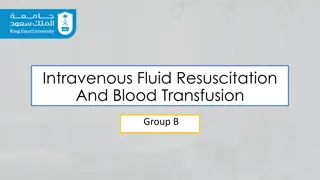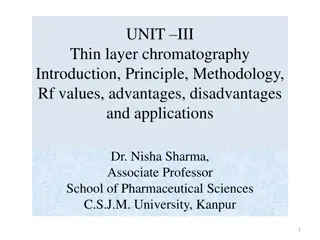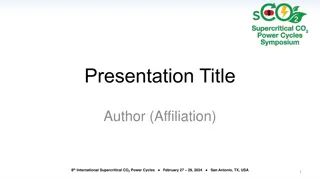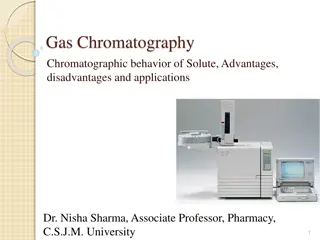Supercritical Fluid Chromatography: History, Principles, and Applications
Supercritical Fluid Chromatography (SFC) has a rich history dating back to the 1960s, utilizing supercritical CO2 as a mobile phase for chromatographic separations. SFC offers advantages such as high efficiency, chiral separations, and green chemistry applications. Despite being overshadowed by HPLC, SFC has seen advancements in column and mobile phase chemistry, allowing for the separation of more polar molecules. The use of co-solvents like methanol or ethanol can enhance extraction efficiency in SFC. Overall, SFC continues to evolve with a focus on preparative separations and green chemistry practices.
Download Presentation

Please find below an Image/Link to download the presentation.
The content on the website is provided AS IS for your information and personal use only. It may not be sold, licensed, or shared on other websites without obtaining consent from the author.If you encounter any issues during the download, it is possible that the publisher has removed the file from their server.
You are allowed to download the files provided on this website for personal or commercial use, subject to the condition that they are used lawfully. All files are the property of their respective owners.
The content on the website is provided AS IS for your information and personal use only. It may not be sold, licensed, or shared on other websites without obtaining consent from the author.
E N D
Presentation Transcript
By Nicole Adams and Morgan Campbell
History and Background Theory Advantages Disadvantages Applications Conclusions
First reported as high-pressure gas chromatography (HPGC) before HPLC in 1962. 1966 first use of supercritical CO2as mobile phase Used a UV absorption detector with a quartz cell equipped with a gas-liquid separator 1968- used a SFC system with a mechanical backpressure regulator that could control pressure independent of flow rate. Basic prototype of modern packed column SFC. 1970- development allowed pressure programming, gave a gradient. Overshadowed by development of HPLC in late 60 s and 70 s. 1980 s led to commercialization of SFC instruments Open tubular columns-more like GC Packed columns-more like LC. Developed chiral separations 1990 s- use of SFC as preparative separation 2000 s- demands for green chemistry has led to more interest in SFE Advances in column and mobile phase chemistry allowed separations of more polar molecules 1
Critical point represents the pressure and temperature conditions under which phase such as liquid and gas cease to exist. 2 2
Has density and solvent power similar to that of a liquid solvent but the viscosity and diffusivity of the same order of magnitude as gases SCF moves like a gas and dissolves substrates similar to a liquid 2,3
The separation of chemicals which are mixed with a supercritical fluid to form a mobile phase which is subjected to pressures and temperatures near or above the critical point for the purpose of enhancing the mobile phase solvating power. Typically, CO2 is used as the supercritical fluid. CO2 is first in vapor form then compressed into a liquid prior to becoming supercritical, where extraction occurs. Supercritical CO2: Critical temperature = 30.9 C Critical pressure = 73.8 bar Critical density = 0.467 gm/ml 2
Co-solvents that are added to CO2 to enhance extraction efficiency Usually 1 to 10% of methanol or ethanol is added to expand the extraction range to include more polar lipids Organic modifiers can increase the complexity of the experimental model that determines SCF extraction parameters 2,4
The necessary apparatus for a SFE setup is simple. Figure depicts the basic elements of a SFE instrument, which is composed of a reservoir of supercritical fluid, a pressure tuning injection unit, two pumps (to take the components in the mobile phase in and to send them out of the extraction cell), and a collection chamber. 5 5
Equilibrium state between the solute and the solvent is achieved before any sample is taken out to analyze the solubility. Static method carries out the equilibrium process in many ways that include recirculation of the solvent, agitation by the magnetic stirrer, or simply trapping the solvent in the equilibrium cell for some time In the static extraction experiment, there are two distinct steps in the process: 1. with the sample. 2. substances are taken out at once. The mobile phase fills the extraction cell and interacts The second pump is opened and the extracted 3,5
In dynamic extraction, the second pump sending the materials out to the collection chamber is always open during the extraction process. Thus, the mobile phase reaches the extraction cell and extracts components in order to take them out consistently. 5
Density: the ratio of the mass of an object to its volume Solubility: the maximum amount of a substance that will dissolve in a given amount of solvent at a given temperature to form a stable solution Viscosity: the resistance of a liquid to flow Diffusivity: the ability of a molecule to mix with a substance by random molecular motion
Determines the intermolecular forces for packing of molecules in the solvent around the molecules of solute. This behavior determines solvation. Retention behavior is also related to the density of the mobile phase, which is provided by the Equations of state (EOS) EOS are relationships that connect the pressure, volume, and the temperature of a given mass of a fluid. Where M is the molecular weight, R the universal gas constant, and Z the compressibility factor. Z = Z(P,T), which is given by the EOS 3,4
There are multiple EOS equations that are very complex. Usually pressure programs help determine what equation is the best fit for the experimental parameters. An example is the Peng-Robinson EOS but the volumetric mass must be calculated numerically. Therefore, the easiest way to derive Z as a numerical solution based on this EOS is from the equation Where is the acentric factor, which can be found in tables 2, 4
Solvent power of a SCF depends on its structure, polarity and its density Solubility parameter of a dense gas can be estimated by: Where / liq is the ratio of the density of the dense gas to that of the liquid at its boiling point. Solubility increases with higher temperatures because of higher vapor pressures but this is offset because decreases with increased temperatures and lower values decrease solubility Initial stages of SCF extraction are governed by the distribution coefficients of the solute between the dense fluid-phase and the sample matrix therefore controlled by solubility 4
Low viscosity enables easy penetration of the SCF in porous solids Viscosity of CO2 is about one order of magnitude smaller than those of typical liquid organic solvents Critical viscosity can be determined by: Where M is molecular weight, c is in micropoise, Pc in atm, Tc in K, and Vc in ml/mol Viscosity of a SCF essentially depends on its density which is a function of the pressure and the temperature 4,6
Viscosity of carbon dioxide as a function of its density at different temperatures. This confirms that viscosity of a fluid , subcritical, critical or supercritical depends essentially on its density but depends little on the temperature alone. 4
SC CO2 has values that are more typical of gases than those of the liquid state Increased diffusivity of an SCF as compared to those of liquid, results in high mass transfer rates Self-diffusion coefficient of SC CO2 is 1-2 orders of magnitude greater than those of dissolved substances in the usual solvents Later stages of SCF extraction are governed by diffusion-controlled process therefore controlled by mass transfer 3, 7
Particle size and shape Surface area and porosity Moisture content Changes in morphology Sample size Extractable levels 2
Green Chemistry Can use MS, FID, UV (particularly PDA in packed columns), ESLD Can use gradients of CO2, modifiers, density, pressure, temperature With modifiers, can analyze a wide range of analytes Can be used for analytical and preparative separations All three parameters-pressure, temperature, modifier content- can independently or cooperatively control retention CO2 is cheap, non-toxic, non-flammable, transmits in the UV, readily available, and a gas at room temperature Much less use of organic solvents-good for EPA and storage/disposal of such solvents CO2 use as a solvent protects lipid samples against oxidative degradation. 1-2, 8-10
Cost-both of equipment and training to operate machine Programming required to optimize results Equipment must be able to handle very high pressures/temperatures Cannot use refractive index detection because of high back pressure required by SFE Polar analytes are comparatively difficult to separate than non-polar analytes unless a modifier is used, making the process less green Due to temperature/pressure/ green requirement limits, CO2 is the only really practical supercritical fluid solvent SFE is not generally selective enough to isolate specific analytes from the matrix without further clean- up/resolution from co-extracted species 1-2, 8-10
Chiral separations most successful application in SFE (including analyte and preparative separations, has been around longest) Extraction of caffeine from coffee beans, tea leaves Metals recovery from solids/liquids Food toxicology and ecotoxicology Solvent removal and new drug delivery formulations (used as an anti-solvent) Natural pesticides De-nicotinization of tobacco Food preservatives Herbal medicines Isolation of natural products 2, 8-10
Supercritical CO2 extraction of Eucalyptus leaves oil Advantages: Extracted a wide range of components-not only volatile oils but high molecular weight compounds. 1,8-cineole (primary desired extract) content was 46.19% Extraction only took 60 minutes, compared to Soxhlet (8 hours) or hydrodistillation (5 hours) Did not have degradation of water sensitive compounds in oil due to partial hydrolysis No solvent residue present in finished product 8
SFE CO2 extraction of bioactive compounds from microalgae and volatile oils from aromatic plants Advantages: It is possible to obtain pure oil fraction on the second column while trapping waxes on first column Extraction of bioactive compounds and volatile oils done without use of organic solvents Microalga had 72g/kg hydrocarbons extracted without contamination by chlorophyll These hydrocarbons can replace paraffinic and natural waxes in production of masks for cosmetic industry-free of toxic solvents 70% of carotenoid content extracted, used as food colorant Composition of extracted volatile oils from pennyroyal yielded 80% pulegone (used as flavoring agent, in perfumery, and aromatherapy. Similar to peppermint and camphor) and 9% menthone (related to menthol), Extraction of compounds from Satureja montana L. (winter savory) had 15 fold higher amounts of thymoquinone (vs. extraction done with hydrodistillation). Thymoquinone has anticancer, antioxidant and anti- inflammatory properties, as well as a neuroprotective effect against Alzheimer s disease. 9
SFE of heavy metals from sand and sewage sludge Advantages: Lack of solvents = environmentally acceptable Morphology and structure matrix is retained Use of a chelating agent (Acetyl acetonate -dissolves in CO2) allowed removal of Cu, Cr, Ni, Pb and Zn In comparison with traditional methods (BCR, Tessier, etc) it is much faster Avoids analytical difficulties that are encountered with sequential extraction methods Uses less harsh conditions than SbWE One extraction removes 30-50% metals present 10
SFE is a relatively green process, little to no solvent in final products CO2 can be recycled and reused In comparison to hydrodistilation and Soxhlet extraction, SFE takes less time to extract desired compounds with less use of organic solvents. Adjustments of pressure/temperature/modifiers can help select for specific analytes To more fully develop SFE as a general use tool; it needs to be cheaper, be able to be more automated, have general lab instrumentation interface International Symposium on Supercritical Fluids (ISSF) held every three years-next held in San Francisco in May 2015
1. Saito, M. J. BioSci. Bioeng. 2013 2. Sairam, P. et al. Asian J.Res.Pharm.Sci. 2012 3. Mantell, C., Casas, L. and et al. 2013 S., Ed.; John Wiley & Sons. 2013 4. Guiochon, G., Tarafder, A., J. Chrom. A. 2011 5. Rice University. Basic Principles of Supercritical Fluid Chromatography and 6. Voutsas, Epaminondas. Supercritical Fluid Extraction. In Food Engineering Handbook: Food Process Engineering; Varzaka, T., Tzia, C., Ed.; CRC Press: Florida, 2014 7. King, J. In Analytical Supercritical Fluid Chromatography and Extraction, Proceedings of 8. Zhao, S. Dongke, Z. Separ. Purific. Tech. 2014 9. Palavra, A.M.F. et al. J. Supercrit. Fluids. 2011 10. Yabalak, E. Gizir, A.M. J. Serb. Chem. Soc. 2013 11. Fornari, T. et al., J. Chrom. A. 2012 2013, 115, 590 2012, 2, 112 2013. Supercritical Fluid Extraction. In Separation and Purification Technologies in Biorefineries; Ramaswamy, 2013; pp 79-98. 2011. 1218, 1037 Supercritical Fluid Extraction. http://oer.equella.com/ (accessed. December 1 2014). 2014; pp 287-318 Chromatography Conferences, Inc.; Lee. M., Markides, K. Ed. Provo, Utah, 1990 362. 2014, 133, 443 2011, 60, 21 1990; pp 313- 2013, 78, 1013 2012, 1250, 34




